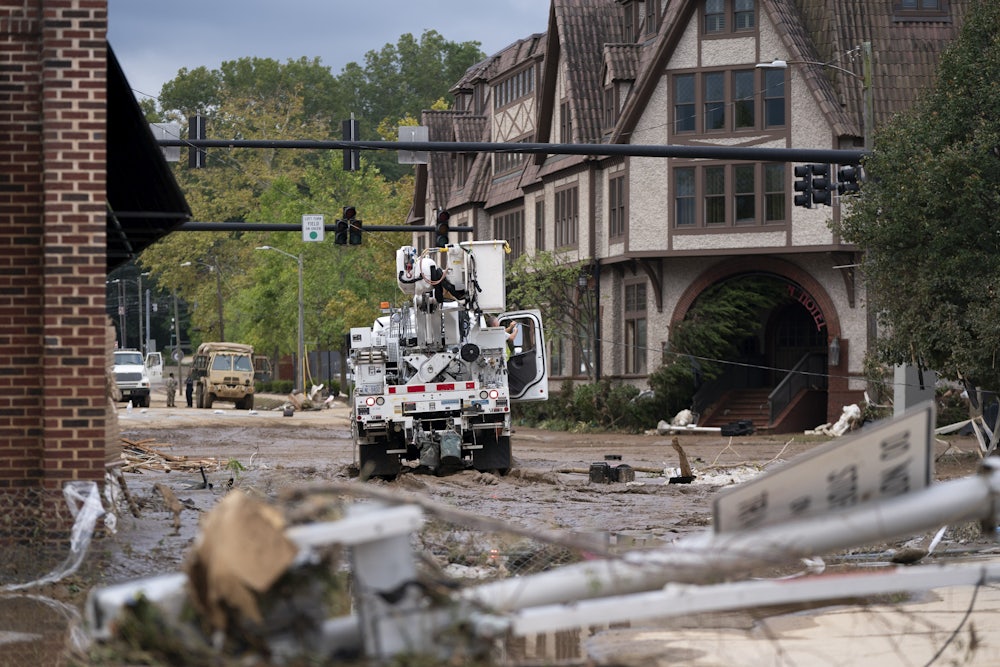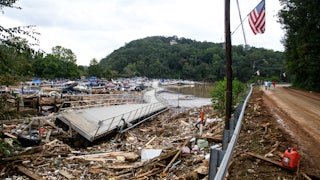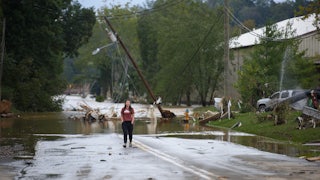Growing up in Asheville during the 1960s and 1970s, restaurateur Kevin Westmoreland saw his neighborhood of Biltmore Village flood—unsurprising, given its location near the French Broad and Swannanoa Rivers. But when tropical storms Ivan and Frances hit Asheville in 2004—amounting to a supposedly “once in a century storm”—floodwaters rose over the front steps of his restaurant, Corner Kitchen. He remembers reaching the front door of the restaurant in a canoe—a shocking sight for a noncoastal area of North Carolina.
Last week, following tropical storm Helene’s deluge, Corner Kitchen flooded to its second floor. The walk-in refrigerators were tossed on their sides, and putrid water filled the dining room of the Biltmore Village establishment. Chestnut, a second restaurant Westmoreland and his business partner, chef Joe Scully, own, is also closed. It didn’t flood, because Chestnut, located in downtown Asheville, is on higher ground. But Chestnut, and most of Asheville, are without water.
Helene “severely damaged the production and distribution system of the City of Asheville’s water system,” the city said in a statement last weekend. “Extensive repairs are required to treatment facilities, underground and aboveground water pipes, and to roads that have washed away which are preventing water personnel from accessing parts of the system. Although providing a precise timeline is impossible, it is important to note that restoring service to the full system could potentially take weeks.” Asheville’s former water director Mike Holcombe told NPR that two of the city’s three water treatment plants, as well as a backup, were disconnected, amounting to “a nightmare.”
I lost water at my home in West Asheville on Sunday afternoon. As of this writing, I have not showered in five days and am using our blender’s pitcher to fill the toilet tank with bathwater anytime I want to flush. Even locations with access to water are under a “boil water” advisory, which has been in place since Saturday.
Infrastructure damage, be it to water systems or power lines or roads, isn’t a surprise after a storm. But catastrophic weather events exacerbated by climate change, combined with a water system stressed by Asheville’s rapid population growth—a 13 percent increase from 2010 to 2020—have driven the system to a breaking point. (Ironically, Asheville’s reputation as a so-called “climate refuge” is at least partially responsible for its population increase, as new residents move in.) Adding to the mayhem, Asheville’s city government and state legislators have had power struggles over stewardship of the water district, with Republican lawmakers blaming the city for allegedly mismanaging funds that should have gone toward repairs.
According to the Third National Climate Assessment, extreme precipitation in the Southeast increased by 27 percent from 1958 to 2012. But Helene is not the first time Asheville has suffered widespread water outages, and not all of those outages have involved flooding. In December and January 2021, cold temperatures froze water equipment, causing 27 water main breaks. Thousands of people were without water over the Christmas holidays, some for over 10 days. An incident report on the 2021 water outage blamed high demand, which overpowered the system’s capacity. Asheville Watchdog, a local investigative journalism outlet, also found miscommunication between teams and a lackadaisical response to the aging water system’s maintenance.

Asheville is an eco-conscious community; it has not had its proverbial head in the sand about the threats posed by climate change. The city enacted a climate resilience plan last year that includes improvements to the water distribution system and stormwater control measures. Yet Helene made it abundantly clear to anyone bathing herself with deodorant wipes at the moment that neither the city nor the state is adequately prepared for the significant pressures that climate change is placing on municipal water systems.
Asheville isn’t exceptional in this regard: Environmental Protection Agency surveys have estimated that $625 billion will be needed in the coming decades just to fix and maintain drinking water infrastructure nationwide—and as much as $944 billion could be needed through 2050 to adapt this infrastructure for climate change resilience.
Statewide, investment figures show recent upticks in funding. According to reporting by Iredell Free News, a newspaper headquartered in Iredell County, North Carolina typically invested about $200 million annually to water system upgrades, but the American Rescue Plan Act infused $2.3 billion more across the nation. In February, the Biden administration announced $361 million in EPA funds for North Carolina to update its water infrastructure, mainly to increase access to clean water.
Such funding is a critical infusion to be sure. But the extent of Helene’s destruction suggests replacements and repairs should have already happened.
After the 2004 tropical storms in Asheville, Corner Kitchen closed for three months. Its building, dated from 1895, had to be demolished and was rebuilt. Westmoreland says that over the past two decades, there have been a number of times both restaurants have had to close for three to four hours at a stretch due to temporary water outages.
Speaking to me outside an empty Starbucks in Biltmore Village on Thursday, Westmoreland seemed to accept that this is the cost of doing business in Asheville today, noting wryly, “I can’t be angry at the climate.” He knows both Duke Power and Water Resources workers are doing what they can to bring services back online, and he appreciates it. The situation in Asheville at the moment is gratitude any time WiFi signal bars improve and more stoplights come on.
But he’d like more future-oriented action. “One thing that I would like to see happen as they’re repairing the water treatment plants and the water infrastructure is that they think ahead to another flood and do what they can to protect that infrastructure accordingly,” he said.
Now Biltmore Village—a tony tourist district of breweries, cigar lounges, a Williams-Sonoma, and a Lilly Pulitzer—lies under a thick layer of mud composed of potentially toxic water. It is drying into brown dust, giving the leafy Blue Ridge Mountain town an eerie Wild West feel.
It’s not clear how long Asheville’s water outage will last. As of Thursday, 85,000 electrical customers also remained without power. There is substantial cleanup ahead throughout Asheville—of mud and dust, crumbled roads, felled trees and branches, and commercial and residential belongings strewn about. On Thursday, Governor Roy Cooper implored tourists to stay away for the time being, bluntly stating, “We don’t want you here.” In response to all this, the restaurateurs have terminated 104 people, between Chestnut and Corner Kitchen.
Corner Kitchen will have to be rebuilt, which Westmoreland estimated could take three or four months, depending on the responsiveness of the federal Small Business Administration. They will open Chestnut whenever power and water are back. “Assuming,” he says, “the water comes back.”
Of course, the water has to come back. Asheville’s residents will wait it out for weeks, or months, if we have to. And we’ll stock our pantries with bottled water, buckets, hand sanitizer, and dry shampoo in anticipation of the next water system failure. Two crashes of the system in just three years—to say nothing of smaller, briefer outages—suggest waiting for the next “big one” is now the cost of living here.








